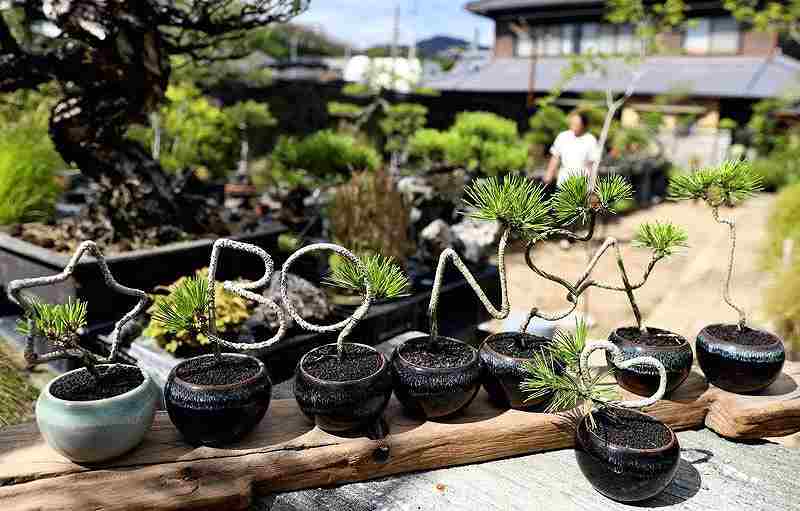
Yomiuri Shimbun photos Bonsai trees are seen shaped like alphabet letters, a star and other symbols at Hanazawa Myoshunen in Takamatsu.
November 21, 2021
TAKAMATSU — Hoping to gain fans among young Japanese and people overseas, bonsai growers in Takamatsu are pursuing a new style that does not adhere to what is conventionally associated with the compact trees.
Bonsai are known worldwide as a compact version of Japanese natural beauty, all concentrated in a single pot. Takamatsu, a major city in Shikoku, is Japan’s largest producer of pine tree bonsai, which is the most typical type.
Various efforts, including producing mini bonsai, are underway in the city’s Kinashi and Kokubunji districts, both of which are home to many bonsai growers.
Hearts and stars
Quirky-looking pots holding thin young pine trees with 1-centimeter-thick trunks stand out among the pots of Japanese black pine with magnificent branches. The small bonsai pots boasted trees shaped like a heart, a star and other symbols, as well as alphabet letters. Fresh needles on the tips of a branch added to how cute the bonsai looked.
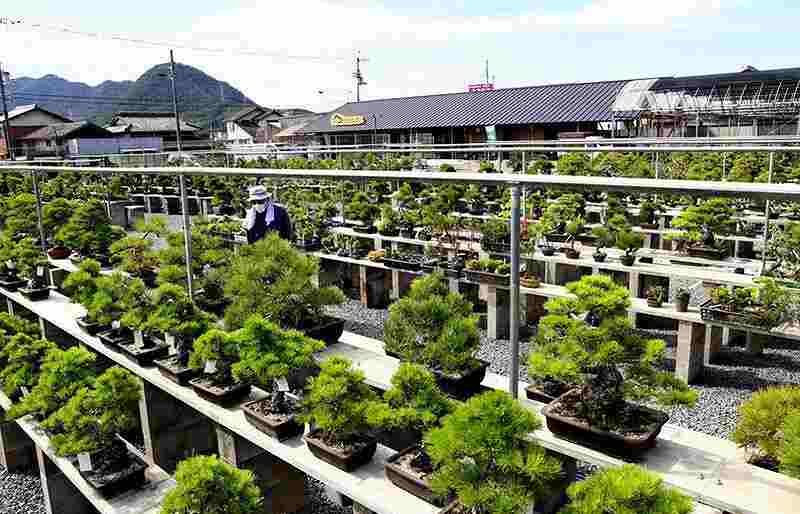
Many bonsai pots are displayed at the Takamatsu Bonsai no Sato facility in Takamatsu.
They were all grown by Michiko Hanazawa at Hanazawa Myoshunen, a bonsai-grower shop in the Kinashi district. She is the 39-year-old daughter of the shop owner, Takahito, 65.
Although the bonsai look unique enough to overturn the conventional image of bonsai, she said she uses a traditional technique to wire trunks and branches to coax them into the desired shapes. To my surprise, it takes one or two years for each tree to adopt the shape.
Hanazawa came up with the idea about 10 years ago, when she was learning under her father. She said it took trial-and-error, bending 2,000 seedlings before she found the perfect way to make the shapes she wanted.
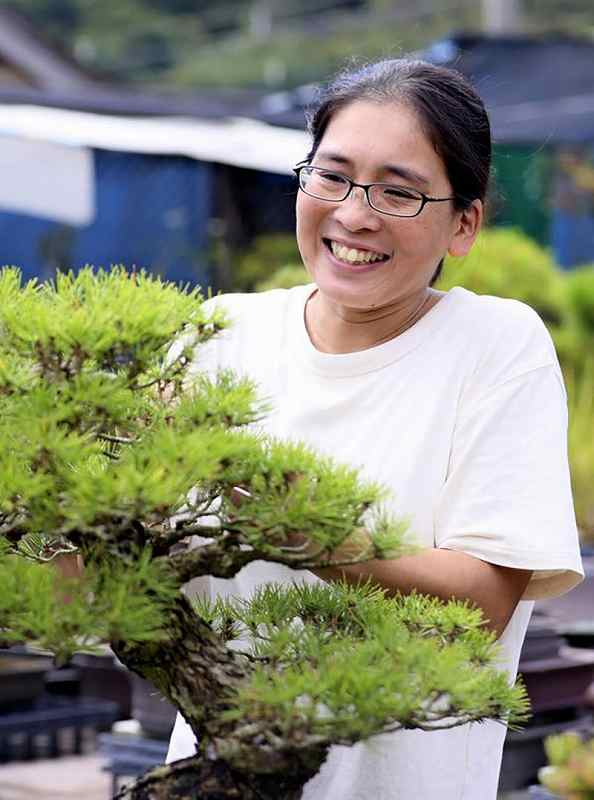
Michiko Hanazawa
For the past few years, her bonsai pots have been shipped to daily-goods stores where they draw the eyes of young women, who often hold up smartphones to take photos while saying, “How cute!”
The Hanazawa bonsai shop is also holding bonsai classes and workshops, proposing “family bonsai,” or bonsai that all family members can enjoy viewing in their homes, such as on a balcony.
Shedding stereotypes
Bonsai production in Takamatsu is said to date back to about 200 years ago, when someone began to plant wild pine trees in pots and sell them. Kagawa Prefecture, including Takamatsu, is in a region on the Seto Inland Sea, where mild and dry weather is suitable for growing the plant.
Mainly using three types of pine trees — Japanese black pine, Japanese white pine and Japanese brocade pine — the “Takamatsu bonsai” became popular after World War II, when Japan saw high growth around the 1960s.
However, lifestyles changed. As more and more people began to live in condominiums that lack gardens, and as bonsai lovers age, demand for bonsai has shrunk. There are also fewer bonsai producers due to a lack of successors.
To cultivate new fans, growers are hoping to shed the preconception that bonsai is an old-fashioned hobby favored by elderly men.
The Kagawa Prefecture Agricultural Cooperative opened a new bonsai facility, the Takamatsu Bonsai no Sato (Takamatsu bonsai village), in April last year in the neighboring Kokubunji district. It showcases and sells about 10,000 bonsai pots, while focusing on providing information mainly for bonsai beginners and young visitors.
The staff carefully teach customers how to take care of bonsai pots from the basics, such as watering and fertilizing. In the facility, I saw a 29-year-old customer carefully choosing his bonsai.
“I’ve been interested in bonsai since I gave one to my father for his birthday. I like them because they look cool,” he said.
More exports
Bonsai has long enjoyed popularity mainly in Asia, Europe and the United States, and growers are trying to export more.
Bonsai trees produced in Kagawa Prefecture are especially popular following an international bonsai trade show that was held in Takamatsu 10 years ago. More than 10,000 bonsai trees from the prefecture are exported each year.
The ways in which people enjoy bonsai seem to vary from region to region in the world.
“In Europe, many people grow bonsai on their own using the wiring technique, while in Southeast Asia, there’s strong demand for large pots to use as ornaments,” said Satoru Oro, chair of the Kagawa Prefecture Bonsai Production Promotion Council. He was impressed by bonsai lovers he saw in Germany. He said they were sharing their tips on how to take care of bonsai in a shop.
While cheap bonsai mass-produced in China and South Korea are dominating the market, Oro and his fellows are looking to Europe. Black pine bonsai, the mainstay of the Takamatsu Bonsai, was allowed to be exported to the European Union in October last year.
The EU lifted export restrictions thanks to the efforts of the Kagawa prefectural government, which provided the EU with information on their measures against disease and pestilence — concerns the EU had — and other relevant data. The remaining challenge is selling the bonsai to Europeans during the pandemic.
“The beauty and high quality of Japanese bonsai has already been widely recognized,” Oro said. “We’d like to further enhance their value by using techniques cultivated by growers in Takamatsu.”
I gazed at the field filled with young pine trees, and the unique view gave me a taste of the pride bonsai growers must feel as they protect the tradition and culture while continuing to take on new challenges.
— How to get there
The Hanazawa Myoshunen is an about 15-minute walk from JR Kinashi Station. By car, you can use the Takamatsu-Danshi Interchange if entering Shikoku via the Onaruto Bridge, or use the Takamatsu-Nishi Interchange if via the Seto Ohashi bridge. Closed on irregular days. The Takamatsu Bonsai no Sato is an about 10-minute walk from JR Kokubu Station. It has parking that can accommodate large buses. It is closed only during the year-end and New Year period.
— Extend your trip!
Momotaro Shrine
Momotaro is a hero in popular children’s folktale who was born from a big peach and fought off demons with a dog, a monkey and a pheasant as his companions. The shrine in the Kinashi district has monuments to these characters.
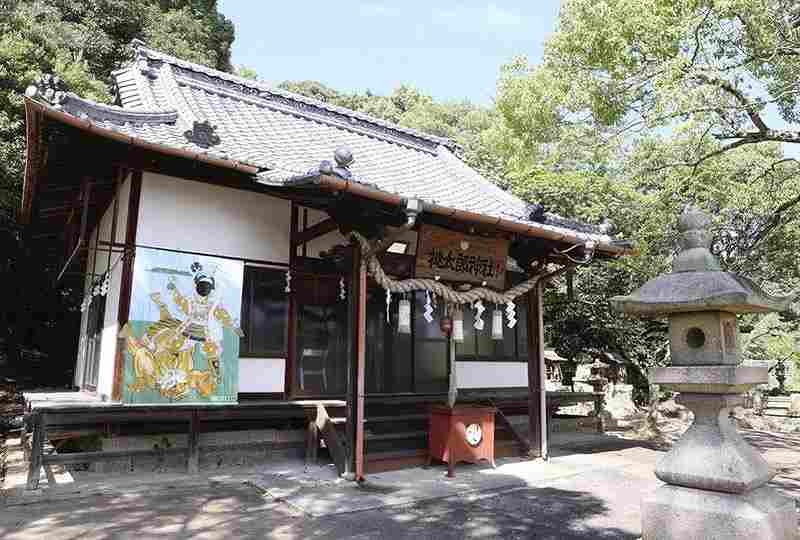
Momotaro Shrine
Its real name is the Kumano Shrine, which enshrines the Kumano Gongen deity who is also said to have expelled demons. In 1930, a local school teacher released an academic paper claiming that the Momotaro legend is set in the Kinashi district, whose kanji characters mean “no demons.”
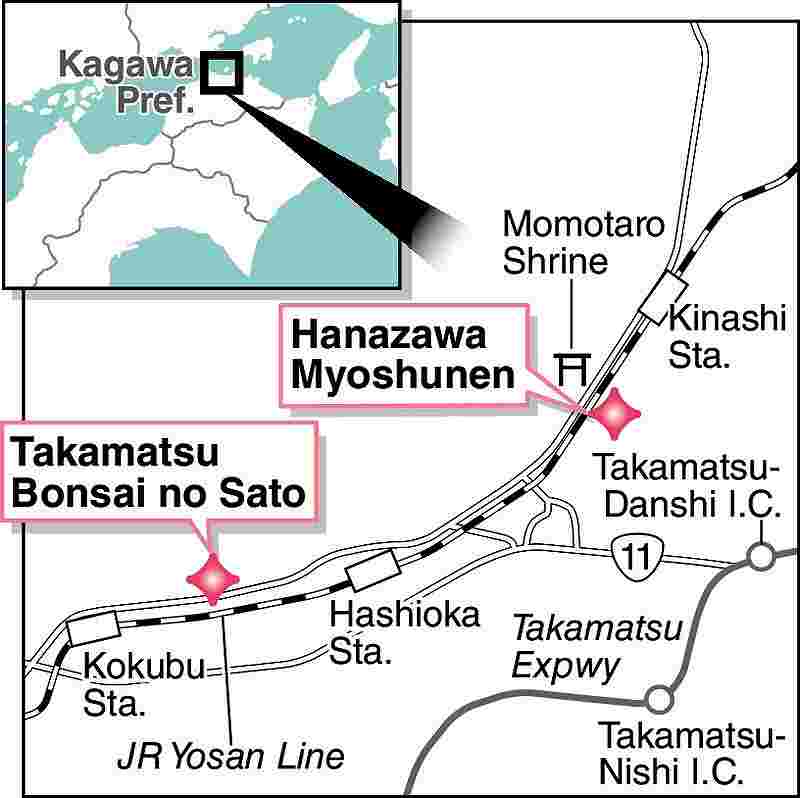
Locals have since nicknamed the shrine the Kumano Gongen Momotaro Shrine.
A festival to pray for the healthy growth of children is held every March.
"Society" POPULAR ARTICLE
-

M4.9 Earthquake Hits Tokyo, Neighboring Prefectures
-

Israeli Tourists Refused Accommodation at Hotel in Japan’s Nagano Pref., Prompting Protest by Israeli Embassy and Probe by Prefecture
-

M7.5 Earthquake Hits Northern Japan; Tsunami Waves Observed in Hokkaido, Aomori and Iwate Prefectures
-

Tsukiji Market Urges Tourists to Avoid Visiting in Year-End
-

High School in Kyoto Says Students Shoplifted during Recent School Trip to Bali, Indonesia
JN ACCESS RANKING
-

Tokyo Economic Security Forum to Hold Inaugural Meeting Amid Tense Global Environment
-

Keidanren Chairman Yoshinobu Tsutsui Visits Kashiwazaki-Kariwa Nuclear Power Plant; Inspects New Emergency Safety System
-

Imports of Rare Earths from China Facing Delays, May Be Caused by Deterioration of Japan-China Relations
-

University of Tokyo Professor Discusses Japanese Economic Security in Interview Ahead of Forum
-

Japan Pulls out of Vietnam Nuclear Project, Complicating Hanoi’s Power Plans























